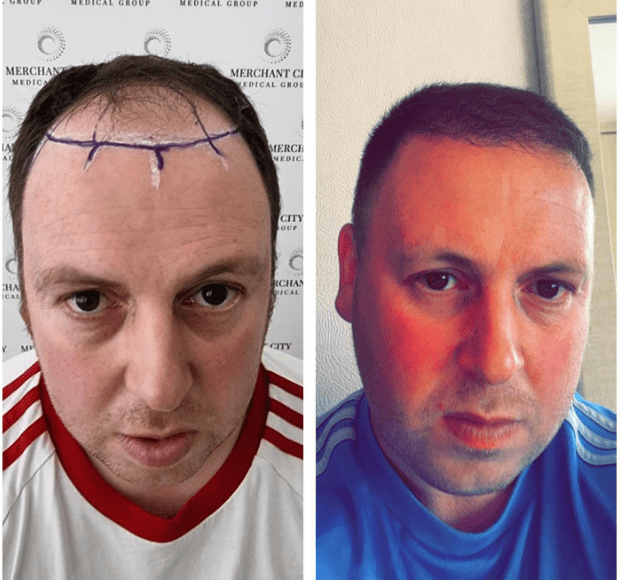
Forehead Reduction Vs. Hair Transplant. Which One Should You Choose?
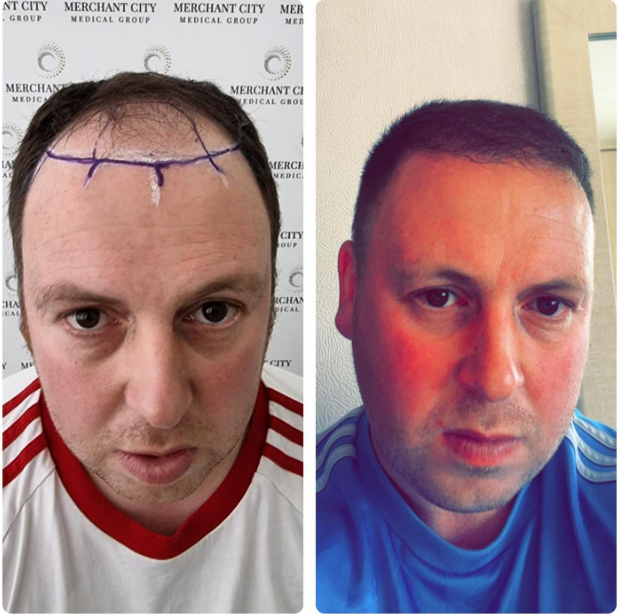
Are you thinking about how hair transplants and forehead reductions differ from one another?
Empower yourself with knowledge by understanding these two common cosmetic options, which are essential for anyone seeking to enhance their looks. Both strive for better facial aesthetics but serve distinct purposes and objectives.
This article will reveal the main differences between a forehead reduction—which reduces the forehead for a more proportionate face—and a hair transplant, which replaces hair in thinning or balding parts.
What is a Hair Transplant Procedure?
Hair transplant or hair restoration, transfers hair follicles from one part of the body to a balding area to stop hair loss and restore a fuller hairline. A hair strip is taken and transplanted in Follicular Unit Transplantation (FUT), a technique for moving individual follicles in Follicular Unit Extraction (FUE) hair transplant. This hair transplant method seeks to provide a natural-looking density of hair and restore hair in thinning areas of the body.
How Does Hair Transplant Work?
To restore hair to balding or thinning sections of the scalp, hair follicles from a “donor area” on the body—typically the sides or back of the head, where hair is more resistant to loss—are transplanted into those areas.
In the new location, the transplanted hair follicles continue to grow hair, covering the sparsely covered parts of the scalp. This gives the patient a new hairline that looks fuller and more natural-looking or covers the balding patches.
Are There Any Benefits Associated with Hair Transplant
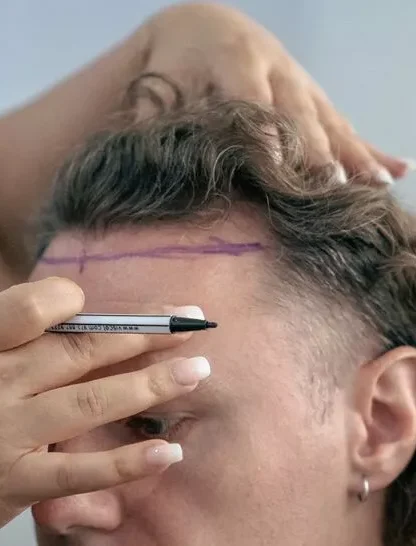
Patient Forehead
There are various benefits to hair transplant surgery:
1. Outcomes that Look Natural
Getting natural outcomes is one of the main advantages of hair transplant surgery. With a smooth appearance, the transplanted hairs sprout out of the scalp.
2. Permanent Remedy
Hair transplant surgery offers a long-term remedy for hair loss. In contrast to certain hair loss therapies that need to be continued, baldness may be permanently treated with a hair transplant.
3. Raises Self-Esteem
A person’s self-esteem can be greatly impacted by hair loss. Hair transplant surgery can help increase self-confidence by restoring a broader hairline.
4. Low Maintenance
Following healing and similar to your natural hair, the transplanted hair usually requires no special care beyond routine washing and styling.
5. Long-Term Cost-Effectiveness
Although hair transplant surgery has a high initial cost, it may be less expensive in the long run than alternative therapies that require continuous costs.
6. Suitable for Several Hair Loss Conditions
Hair transplant surgery can treat hair thinning, male or female pattern baldness, hair loss following trauma or burns, and other forms of hair loss.
What is a Forehead Reduction Surgery
A forehead reduction, also known as a scalp advancement or hairline lowering operation, is a cosmetic surgery used to reduce the appearance of a receding or high hairline and make the forehead appear smaller. A forehead reduction is not advised for those experiencing advanced or active hair loss, as it might promote hair loss and change the hairline.
Certain forehead reduction operations are coupled with hair transplantation or grafting techniques to enhance hair regrowth, optimise overall appearance, and improve the hairline simultaneously. Facial feminization frequently involves forehead reduction.
What Aesthetic Issues Is a Forehead Reduction Operation Intended to Address?
- Forehead Shape and Size: During a forehead reduction, also known as hairline lowering surgery, the hairline is advanced towards the eyes to change how the brow, forehead, and hairline appear.
- Hair Loss: A forehead reduction procedure can alter the appearance of a person who is experiencing undesired changes to their hairline.
- Confirmation of MTF Gender: Candidates who undergo forehead reduction can achieve their ideal body aesthetic.
The Difference Between a Forehead Reduction Operation and a Hair Transplant?
Hair transplantation addresses hair loss and encourages natural growth by transplanting healthy follicles to balding regions. Rather than treating hair loss directly, forehead reduction surgery, also known as hairline lowering, surgically removes forehead skin to reduce the forehead’s size and enhance facial equilibrium.
Here is a tabulated difference between forehead reduction and hair transplant surgery.
| Criteria | Forehead Reduction Surgery | Hair Transplant Surgery |
|---|---|---|
| Approach | This entails incision along the hairline, removing some of the forehead skin, and stitching the scalp closer to the brows. | It includes extracting hair follicles from a donor region and implanting them into areas experiencing hair loss or thinning |
| Issue Tackled | Primarily aimed at individuals who perceive their forehead as disproportionately large and desire to diminish their hairline. It does not tackle issues related to hair thinning or baldness | Tailored for patients encountering hair loss, thinning hair, a receding hairline, or bald patches. It aims to populate these areas with existing hair |
| Recovery Period | Initial recovery spans approximately 1-2 weeks. Complete healing may extend over several months | Recovery duration varies depending on the technique. FUE: Swift recovery (few days). FUT: Might necessitate a lengthier healing phase. Final results may manifest after a year or more |
| Potential Synergy with Other Procedures | It can be amalgamated with additional cosmetic interventions such as brow lifts or hair grafts | Less frequently paired with other procedures. It can be coupled with treatments like PRP therapy |
| Suitability | Appropriate for both men and women with a prominently high hairline or expansive forehead, provided they possess adequate scalp flexibility. Not recommended for individuals with a history of hair loss or a receding hairline | Suitable for individuals boasting ample donor hair on their scalp or body, experiencing balding, thinning hair, or a receding hairline. Requires the patient to maintain good overall health and harbor realistic expectations regarding the outcome |
| Cost Difference | Generally lower cost compared to hair transplant surgery | Hair transplant surgery is typically more expensive due to the complexity of the procedure, the number of grafts required, and the expertise of the surgeon |
Can you combine Forehead Reduction and Hair Transplant Surgeries With Other Methods?
Combining forehead reduction surgery with other cosmetic operations like brow lifts or, strangely enough, hair transplants are common. This is because, in certain situations, a hair transplant can help soften the appearance and provide a more natural-looking hairline when the forehead is reduced.
In contrast, hair transplants are less frequently paired with other treatments because they aim to improve the hairline, and restore thinning or bald spots on the scalp. Nevertheless, they can be used in conjunction with therapies like PRP (Platelet-Rich Plasma) therapy to improve outcomes and encourage hair growth.
Suitability
The last significant distinction concerns who is suitable for each procedure. Males and females with a high hairline or broad forehead with enough scalp flexibility can undergo forehead reduction surgery. However, it is inappropriate for people with a receding hairline or a history of hair loss.
Those with enough donor hair on their scalp or body should consider hair transplant surgery. People who are going through baldness, thinning hair, or a receding hairline may be among them. It’s important to remember that a patient must be in good general health and have reasonable expectations for the results of their hair transplant procedure for it to be effective.
before the hair transplant
Forehead Reduction vs. Hair Transplant: Which Suits You?
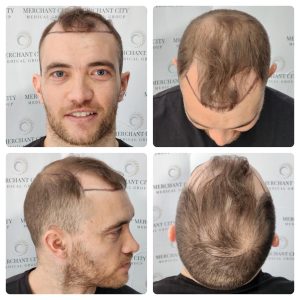
before the hair transplant
People who are self-conscious about their forehead size or who want to lower their hairline are typically better candidates for forehead reduction surgery. Alternatively, hair transplant surgery might be a better option if you’re experiencing baldness, thinning hair, or hair loss and want to add more hair to these areas for a fuller look.
Through this process, hair is transferred from one area of the scalp—typically the one where hair development is still vigorous—to the parts that are losing hair. Recall that these operations entail a substantial financial commitment, each with a unique set of possible dangers and problems. It’s critical to discuss your alternatives with a licensed and experienced healthcare provider before you decide.
After the hair transplant
The Take Away Point
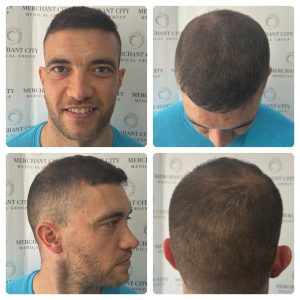
After the hair transplant
The decision between hair transplant surgery and forehead reduction surgery is very personal. Several criteria influence it, such as overall health, general hair and scalp condition, and personal aesthetic aspirations. It’s important to remember that both operations are important choices that require careful consideration and evaluation by a licensed medical practitioner.
It is imperative to remember that these surgeries are quite expensive and may entail dangers. Therefore, it is sensible to investigate non-invasive options. The main objective is to feel good about yourself and at ease in your skin, no matter your route.
Be careful to consider all of your options, balance the advantages and disadvantages, a well-informed selection that meets your goals and needs.
What is more?
Merchant City Medical Group provides surgical and non-surgical cosmetic procedures from our state-of-the-art UK and European clinics. Experience our specialist hair loss treatment and enjoy our surgeons’ expertise today.
Book your free consultation now.

